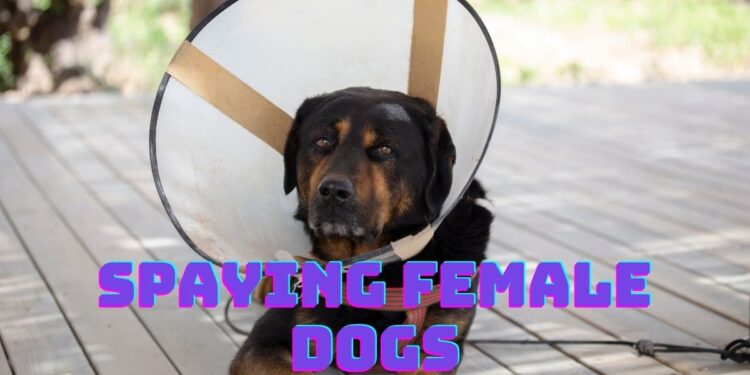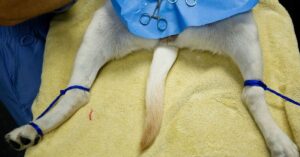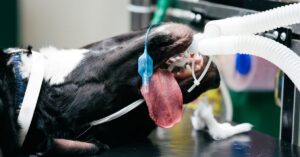‘Spaying a female dog’!!!
Pet parents all over the world have intermittently shared their opinions on this particular topic for decades now. While many support this decision, others combat the choice by claiming it to be cruel for the dogs. However:
It has been proven that spaying a female dog ensures a healthier and longer life to the canines. Fixed females run no risk of ovarian cancer as the process in itself includes removal of the entirety of ovaries from their body. This also leads to a reduced frequency of uterine tract infections, mammary gland issues, and cervical ulcers. As a result you get a happy, healthy female dog at your side for life.
Table of Contents
What is spaying in dogs?
Ovariohysterectomy, also commonly known as spaying, is a surgical procedure which involves complete sterilisation of a female dog. In this procedure, the veterinarian surgically removes the ovaries and uterus of the canid which makes the female unable to conceive or bear children. Additionally, as the female dog has no longer ovaries, the brain doesn’t produce estrogen in bulks and hence they don’t come into heat two times a year as intact females.
In recent times, many veterinarians are also opting for ovariectomy, a process which involves removal of the ovaries only. This choice is mostly because it is much faster as compared to the former method and hence doesn’t require the canid to be put under anaesthesia for a long time.
How is spaying done in dogs?
Generally the process is advised when the canid is 4-6 months old. This is because the pup is by then healthy and strong enough to recover well and fast from the surgery. However, if required, older female dogs may also undergo this surgery once approved by the vet.
Spaying a dog is not a child’s play and therefore includes numerous steps for its efficacy. These include:
-
Pre-health exam
Before a female dog is green-flagged for the surgery, it has to go through several tests to make sure the surgery would be safe on her. Various factors like weight, age, medical history, existing medications and health issues will be taken into account prior to the decision making.
-
Administration of anaesthesia
Once approved by the vet, the medical team will then do a pre-anaesthetic exam. This is to confirm that the little woofer won’t suffer from any anaesthesia related effects during or after the surgery. Not all dogs have similar body composition, and hence in some their bodies might react aggressively to the components, requiring a substitute sedation process.
-
Preparation for the surgery
If everything goes well, then the surgical team proceeds to attach essential medical devices into the dog’s body. This allows them to track the pup’s breathing rate, blood pressure level, heart rate, oxygenation levels, body temperature and even the current efficacy of the general anaesthesia within their body.
-
Surgery Minutes
Upon the commencing of the surgery, the surgeon will make a small incision on the lower part of the abdomen. Afterwards, the surgeon inserts a special tube to remove the uterus and ovaries (ovariohysterectomy) or only ovaries (ovariectomy) depending upon the owner’s approval. The incision is then closed with sutures and may be followed by therapeutic LASER therapy to reduce local swelling and discomfort.
-
Post-surgery care
The fixed female is now transferred to the general ward where owners can visit her until the pup wakes up. A nurse also generally accompanies and monitors the whole situation. Later depending upon the vet’s advice, the pup may either be discharged or kept hospitalised for a day or two before being allowed to go back to her family.
What are the benefits of spaying a dog?
So, as we discussed previously, spaying a dog reduces the seasonal bulk production of estrogen in their bodies, therefore preventing them from coming into heat. But are there any other benefits? Let’s have a look at some of them.
-
No estrus
First of all, starting with the main advantage, there is no estrus for a fixed female dog. They don’t come into heat, don’t show any sudden behavioural and physical changes, and hence you won’t have to worry about attracting every other male dog in your area whenever you take the canid out for a walk. Moreover, the female won’t also try to escape in case she is not allowed to mate with other potential suitors.
-
No red spots on the floor
Another happy news for rather strict pet parents, spaying your female dog also means that you won’t have to spend your days worrying about how to get rid of the red spots on your carpet. So, you can now enjoy white couches or floors without any issues. Apparently, as they won’t go into heat, there will be no cramps or other uncomfortable side-effects.
-
No risk of uterine tract infections
Moreover as spayed females don’t bleed, they are not exposed to harmful microbes during their vulnerable period. This means they won’t be suffering from uterine tract infections, such as pyometra or urinary incontinence during their lifetimes. These infections also occur due to fluctuating hormonal changes and thanks to the lifelong fixing, that too shall not be an issue.
-
No exposure to cancer spread outs
Finally, opting for the surgical removal of their uterus and ovaries also reduces the chance of breast, ovarian, and uterine cancer by several folds. Sometimes, the hormonal changes in intact females cause much more side effects within the body than visible, leading to the cancerous spread outs. However, as proven by various studies, spaying a canid before their first heat, prevents the risk of such cancers by a huge amount. Hence, the dog can spend his life much more healthily and happily, as compared to an intact dog.
Then why do some pet parents oppose spaying?
Even though the majority of consensus prefer spaying as the better choice, some pet parents have opposing opinions as mentioned below.
- Some pet parents deem spaying as a cruel method because it prevents the female dog from ever bearing puppies.
FACT- This is indeed the best part of undergoing the process. Unless and until you are going to breed them until they can, that too with humane ways, you might consider not spaying them. But if you don’t, keeping them intact will not only be problematic for you but also emotionally and physically overbearing for your dog. Just imagine, being constricted within a small space, with no mate, and no possible way to gain pleasure during that time of the month.
- They suppose spaying a canid makes it prone to being overweight, which is ABSOLUTELY FALSE.
FACT- Opting for the surgery in no way induces any behavioural, physical, or psychological changes to your dog. Rather, a fixed female will show more inclination to working out for extended periods of time all over the year, as she no longer has to worry about going into that uncomfortable phase again.
- They consider spaying is an expensive affair and not worth the expense.
FACT- For cost related worries, speaking to your veterinarian can come handy. Many hospitals offer budget-friendly spaying assistance and hence you can seek their consultation if thinking about the surgery. And if wondering about the surgery’s worth, well, your female dog is going to live longer, happier and much more comfortable for the rest of her life. What more do you need???
- Some may even claim the process to be a nuisance and hindrance in the pup’s general growth pattern.
FACT- Now, this is utter nonsense. No matter if you spay your dog when it is 4-6 months old or later during her life, the surgery won’t affect her normal growth pattern in any way. The surgery when done properly also doesn’t risk or make them prone to any health conditions, although for this the after-care needs to be of the optimal level.
Should I spay my dog or not – The Final Answer?
Like we said earlier, spaying is the best thing that you can offer your female unless she is of the highest show breed quality and you want to have her bred for puppies. Apart from that, as a pet parent you must determine their health condition, age, medical history, and other essential factors before going for the surgery.
So, ultimately having her spayed or not is what you yourself and your vet needs to decide upon. But whatever your choice is, don’t forget to take your beloved pooch’s best interests into account.
If you are a dog lover then, Subscribe to our weekly newsletters. No Spams!














